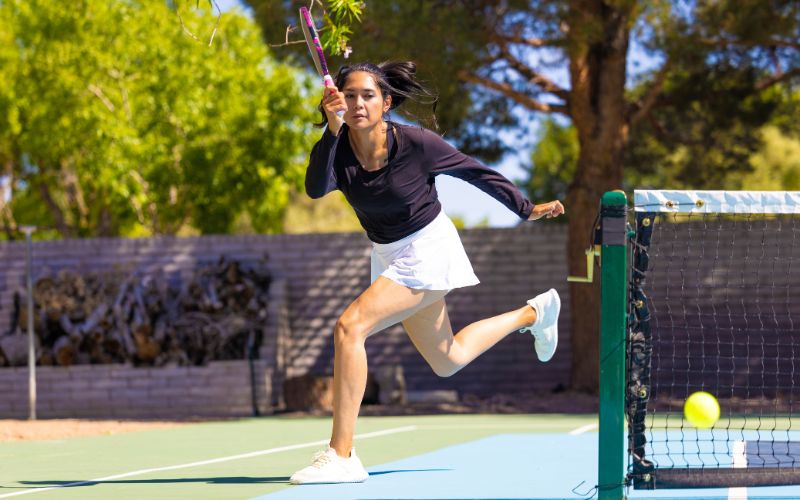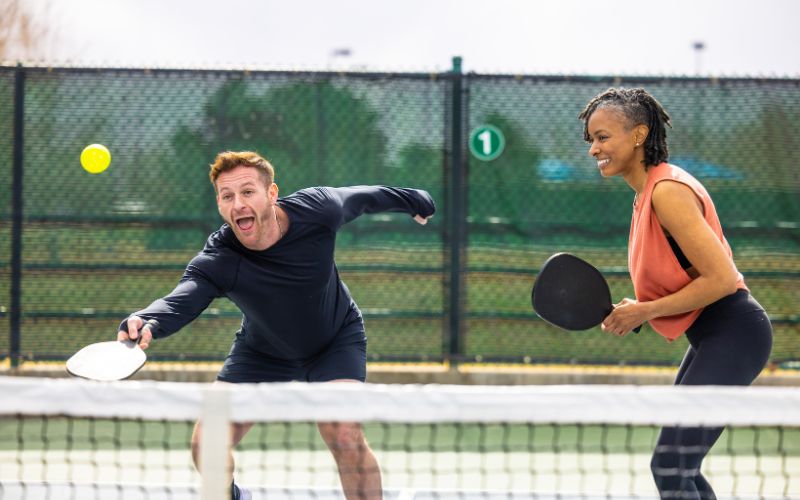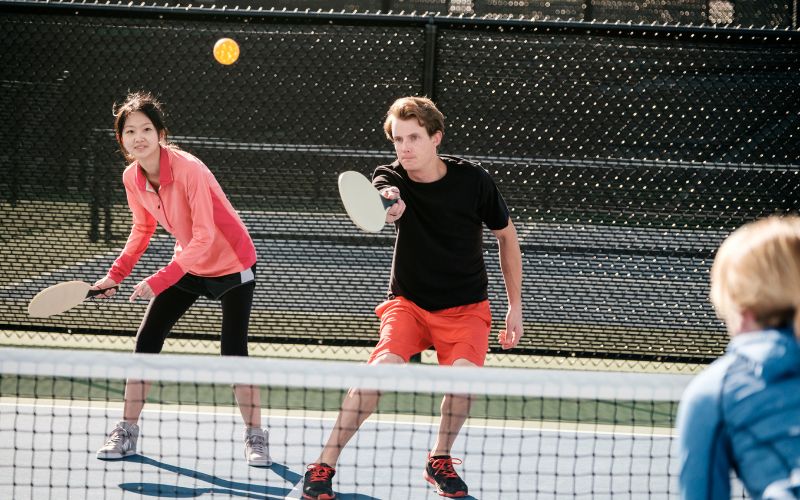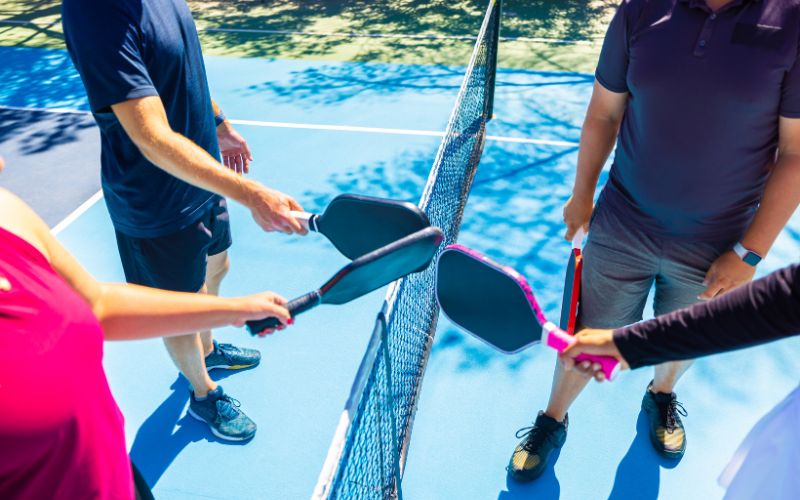Pickleball, a dynamic and engaging sport, combines elements of tennis, badminton, and ping-pong. It’s known for its fast-paced rallies and accessibility, making it a favorite among players of all ages. Whether you’re a novice or an experienced player, honing your skills through effective drills is crucial to mastering the game.
Understanding Pickleball Basics
Before diving into pickleball drills for beginners, it’s essential to grasp the fundamental aspects of the game. Pickleball is typically played on a court with similar dimensions to a badminton court. The game involves the use of a pickleball paddle and a perforated plastic ball. Players compete in either singles or doubles, aiming to score points while abiding by specific rules, including the non-volley zone or the “kitchen” area.
Mastering the Forehand and Backhand Shots
Forehand Shots:
Mastering the forehand shots involves developing proper technique to ensure accuracy and power in your hits. Beginners often benefit from drills that focus on maintaining a good position and generating more power in their shots.
Backhand Shots:
Similarly, improving backhand shots demands dedicated practice. Drills emphasizing hand-eye coordination and hitting the ball at different angles can significantly enhance your backhand skills.
Essential Pickleball Solo Drills for Beginners
1. Selfie Ball Bounce
What is the Selfie Ball Bounce Drill?
The Selfie Ball Bounce drill involves using video recording, such as a smartphone or camera, to record yourself while practicing pickleball. Set up the recording device in a way that it captures your gameplay, focusing particularly on your pickleball technique and shots.
How Does it Help Beginners?
Self-Assessment:
The primary benefit of the Selfie Ball Bounce drill is self-assessment. By reviewing the recorded footage, beginners can analyze their stance, grip, swing, and footwork. It provides an opportunity to identify errors or areas that need improvement.
Technique Refinement:
Watching the footage helps players understand their shot mechanics and allows them to make necessary adjustments. It’s an excellent way to refine form, timing, and shot accuracy.
Progress Tracking:
Consistently recording practice sessions enables players to track their progress over time. Comparing older recordings with recent ones showcases improvements and highlights areas where further focus is needed.
Tips for Effective Selfie Ball Bounce Drills:
- Ensure the recording device captures the entire pickleball court to assess your positioning.
- Analyze the footage to correct any flaws in your technique, footwork, or shot selection.
- Use slow-motion or pause features to closely examine specific parts of your gameplay.
2. Pickleball Wall Drills
What are Pickleball Wall Drills?
Pickleball wall drills involve practicing hitting against a wall. Stand at a distance from the wall and hit the ball, allowing it to bounce back to you. This drill helps improve various aspects of your game, including ball control, hand-eye coordination, and reaction time.
How Does it Benefit Beginners?
Consistent Ball Hitting:
The wall provides a consistent surface for hitting the ball, allowing beginners to practice hitting shots repeatedly. This repetitive practice helps in developing muscle memory and shot consistency.
Solo Practice:
Since it doesn’t require a partner, pickleball wall drills are ideal for solo practice sessions. Beginners can work on their forehand and backhand shots without depending on another player.
Precision and Control:
By focusing on hitting the ball accurately against the wall, players can work on placement and control of their shots.
Tips for Effective Pickleball Wall Drills:
- Use different angles and shots, such as forehand and backhand dinks, to challenge yourself.
- Gradually increase the pace and intensity of your hits to simulate game-like scenarios.
- Maintain a proper stance and footwork even when practicing against the wall.
3. Serve Repeats
What are Serve Repeats?
Serve repeats involve practicing your pickleball serves repeatedly from one side of the court. This drill aims to improve the consistency, accuracy, and placement of your serves.
How Does it Help Beginners?
Serve Technique Improvement:
Practicing serves repeatedly allows beginners to work on their serve motion, ball toss, and contact point. Consistent repetition aids in refining the technique.
Confidence Building:
Repeatedly executing serves enhances confidence in delivering serves accurately during a game. This drill helps reduce nerves associated with serving.
Targeted Practice:
By aiming for specific spots on the court, such as the opposite corner or the non-volley zone, players can focus on serving with precision.
Tips for Effective Serve Repeats:
- Practice serving to different areas of the court to develop a versatile serve.
- Maintain proper body positioning and balance while serving.
- Experiment with different spin variations, like topspin or slice, to add diversity to your serves.
Essential Double Pickleball Drills for Beginners
4. Cross-Court Dinks
What Are Cross-Court Dinks?
Cross-court dinks focus on hitting soft, controlled shots diagonally across the net. Players stand on opposite sides of the court and practice hitting these shots back and forth, aiming to keep the ball low and within the non-volley zone.
How Does it Help Beginners?
Control and Placement:
This drill emphasizes precision and placement of shots, enhancing a player’s ability to maneuver the ball accurately.
Footwork and Positioning:
Players practice moving laterally across the court, improving their footwork and ensuring they maintain an optimal position to hit the ball.
Communication and Synchronization:
It encourages communication between partners to ensure smooth exchanges, fostering teamwork and synchronization.
5. Forehand and Backhand Dinks
What Are Forehand and Backhand Dinks?
In this drill, players focus separately on their forehand and backhand dinks. They alternate hitting these shots to each other, allowing both partners to practice and refine their shots on both sides.
How Does it Benefit Beginners?
Balanced Skill Development:
Players develop proficiency in both forehand and backhand dinks, ensuring a well-rounded skill set.
Adaptability:
By practicing both shots alternately, players become more versatile, enabling them to adjust their gameplay based on the ball’s positioning.
Shot Consistency:
Repeatedly hitting forehand and backhand dinks helps in improving shot consistency and control.
6. Triangle Dinks
What Are Triangle Dinks?
In this drill, three players form a triangle on the court. Each player hits the ball to the other two players alternately, focusing on maintaining a consistent and controlled rally.
How Does it Help Beginners?
Movement and Coordination:
Triangle dinks improve players’ movement and coordination as they navigate the triangular setup.
Awareness and Decision-Making:
Players develop court awareness and decision-making skills by quickly determining the best shots based on the ball’s trajectory and positioning.
Adaptation to Varying Shots:
It challenges players to adapt to shots from different angles, enhancing their ability to respond effectively.
7. Crosscourt Forehand and Backhand Dinks
What Are Crosscourt Forehand and Backhand Dinks?
Players stand diagonally across from each other and practice hitting both forehand and backhand dinks in a crosscourt manner, focusing on controlled shots while covering a diagonal distance.
How Does it Benefit Beginners?
Angled Shots Practice:
This drill enhances the ability to hit shots at an angle, preparing players for more complex in-game scenarios.
Consistency and Control:
It emphasizes maintaining consistency and control while hitting dinks across the court.
Partner Communication:
Players learn to communicate effectively with their partner to ensure smooth exchanges and continuous rallies.
8. Alternating Forehand and Backhand Dinks
What Are Alternating Forehand and Backhand Dinks?
In this drill, players take turns hitting either forehand or backhand dinks to each other. The focus is on alternating between forehand and backhand shots continuously.
How Does it Help Beginners?
Shot Variety:
Practicing alternating shots helps in developing a variety of shots, making gameplay less predictable for opponents.
Hand-Eye Coordination:
Players improve their hand-eye coordination by quickly switching between forehand and backhand shots.
Reflex and Reaction Time:
It enhances reflexes and reaction time as players respond swiftly to varying shot placements.
Other Pickleball Drills for Beginners
1. Third Shot Drop:
The third shot drop is a fundamental technique in pickleball, involving a soft shot played from the baseline to the non-volley zone. Practicing this shot with a partner or through solo drills helps develop precision and contro
4. Shadow Swings for Technique Refinement:
A shadow swing drill involves mimicking shots without a ball. It’s an excellent method to work on form and technique without the pressure of hitting the ball.
Advancing Skills Beyond the Basics
1. Third Shot Drive:
Moving from the third shot drop to the third shot drive signifies an advancement in skills. This shot involves hitting the ball with more pace and can be practiced through various drills for beginners.
2. Selfie Ball Bounce:
An innovative drill like the selfie ball bounce uses video recording to analyze and improve your shots. This drill helps in self-assessment and offers insights into areas needing improvement.
Tailoring Drills for Progression
1. Partner Hit for Advanced Players:
For more experienced players, a partner hit drill involves hitting the ball to your partner’s opposite side of the court. It challenges players to master placement and strategy.
2. Opponent’s Kitchen Drill:
Focusing on hitting shots directly into your opponent’s kitchen can enhance your ability to control and maneuver the ball precisely where you want it.
Importance of Consistent Practice
Consistency in practice is key to mastering pickleball. Whether it’s perfecting drop shots, refining forehand and backhand shots, or improving hand-eye coordination, regular practice is essential to progress. Drills that incorporate a mix of these elements contribute to a well-rounded skill set.
Conclusion
In pickleball, drills for beginners lay the foundation for a player’s growth. From mastering the basics of forehand and backhand shots to advancing to more complex strategies, a tailored practice routine can significantly impact one’s gameplay. The key lies in dedication, regular practice, and a willingness to continually improve. Incorporating a variety of pickleball drills ensures a comprehensive skill development process that caters to players at all levels of expertise.







